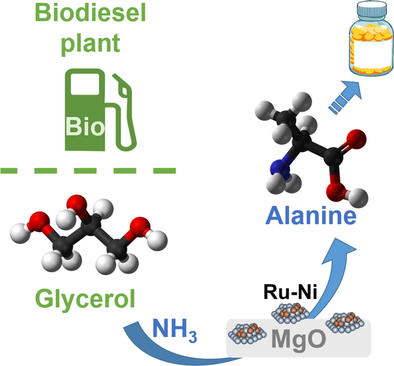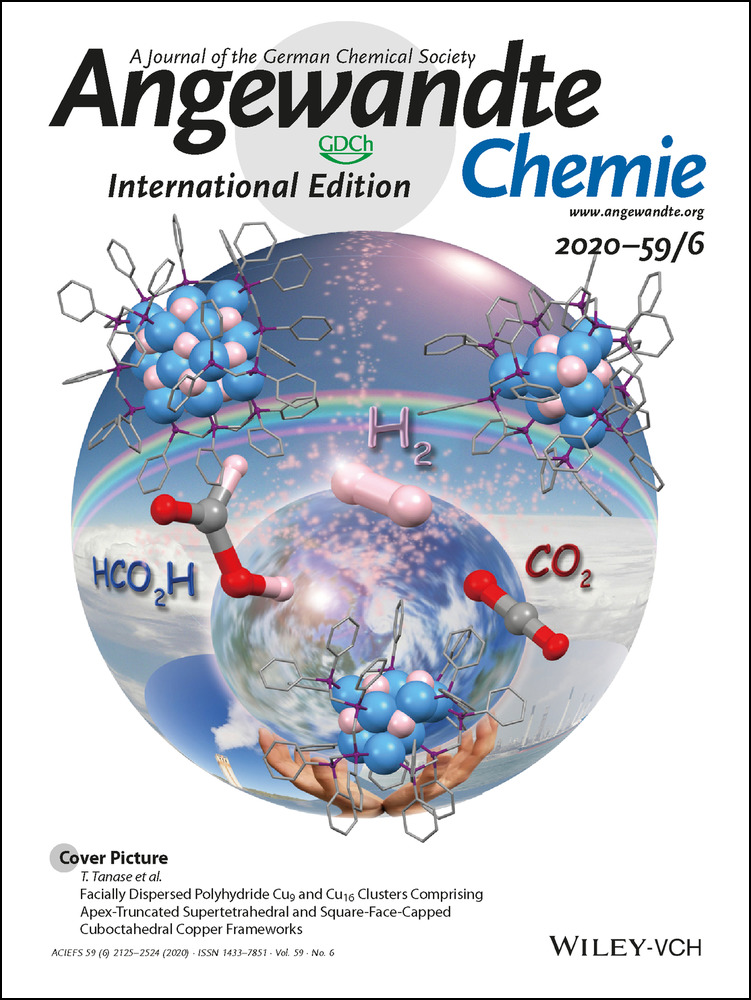Catalytic Production of Alanine from Waste Glycerol
Dr. Yunzhu Wang
Department of Chemical and Biomolecular Engineering, National University of Singapore, 4 Engineering Drive 4, Singapore, 117585 Singapore
Search for more papers by this authorProf. Dr. Shinya Furukawa
Institute for Catalysis, Hokkaido University, N-21, W-10, Sapporo, 001-0021 Japan
Elements Strategy Initiative for Catalysis and Battery, Kyoto University, Kyoto Daigaku Katsura, Nishikyo-ku, Kyoto, 615-8510 Japan
Search for more papers by this authorDr. Song Song
Department of Chemical and Biomolecular Engineering, National University of Singapore, 4 Engineering Drive 4, Singapore, 117585 Singapore
Search for more papers by this authorProf. Dr. Qian He
Department of Materials Science and Engineering, National University of Singapore, 9 Engineering Drive 1, Singapore, 117575 Singapore
Search for more papers by this authorProf. Dr. Hiroyuki Asakura
Department of Molecular Engineering, Graduate School of Engineering, Kyoto University, Kyotodaigaku Katsura, Nishikyo-ku, Kyoto, 615-8510 Japan
Elements Strategy Initiative for Catalysis and Battery, Kyoto University, Kyoto Daigaku Katsura, Nishikyo-ku, Kyoto, 615-8510 Japan
Search for more papers by this authorCorresponding Author
Prof. Dr. Ning Yan
Department of Chemical and Biomolecular Engineering, National University of Singapore, 4 Engineering Drive 4, Singapore, 117585 Singapore
Search for more papers by this authorDr. Yunzhu Wang
Department of Chemical and Biomolecular Engineering, National University of Singapore, 4 Engineering Drive 4, Singapore, 117585 Singapore
Search for more papers by this authorProf. Dr. Shinya Furukawa
Institute for Catalysis, Hokkaido University, N-21, W-10, Sapporo, 001-0021 Japan
Elements Strategy Initiative for Catalysis and Battery, Kyoto University, Kyoto Daigaku Katsura, Nishikyo-ku, Kyoto, 615-8510 Japan
Search for more papers by this authorDr. Song Song
Department of Chemical and Biomolecular Engineering, National University of Singapore, 4 Engineering Drive 4, Singapore, 117585 Singapore
Search for more papers by this authorProf. Dr. Qian He
Department of Materials Science and Engineering, National University of Singapore, 9 Engineering Drive 1, Singapore, 117575 Singapore
Search for more papers by this authorProf. Dr. Hiroyuki Asakura
Department of Molecular Engineering, Graduate School of Engineering, Kyoto University, Kyotodaigaku Katsura, Nishikyo-ku, Kyoto, 615-8510 Japan
Elements Strategy Initiative for Catalysis and Battery, Kyoto University, Kyoto Daigaku Katsura, Nishikyo-ku, Kyoto, 615-8510 Japan
Search for more papers by this authorCorresponding Author
Prof. Dr. Ning Yan
Department of Chemical and Biomolecular Engineering, National University of Singapore, 4 Engineering Drive 4, Singapore, 117585 Singapore
Search for more papers by this authorGraphical Abstract
Direct conversion: 43 % alanine was achieved from crude glycerol over a Ru1Ni7/MgO catalyst. Ni-doped Ru remarkably promoted lactic acid amination, a key step in the reaction. The catalytic route creates new opportunities for glycerol utilization and enriches the substrate scope of renewable feedstock to access value-added amino acids.
Abstract
Chemical synthesis of amino acids directly from biomass feedstock is rare. Reported here is a one-step protocol to convert crude glycerol, from the biodiesel industry, into 43 % alanine over a Ru1Ni7/MgO catalyst. The multifunctional catalytic system promotes glycerol conversion into lactic acid, and then into alanine. X-ray absorption spectroscopy and scanning transmission electron microscopy revealed the existence of bimetallic RuNi species, whereas density-functional theory calculations suggested Ni-doped Ru substantially decreased the Ea of C−H bond dissociation of lactate alkoxide to form pyruvate, which is the rate-determining step. The catalytic route established in this work creates new opportunities for glycerol utilization and enriches the substrate scope of renewable feedstock to access value-added amino acids.
Supporting Information
As a service to our authors and readers, this journal provides supporting information supplied by the authors. Such materials are peer reviewed and may be re-organized for online delivery, but are not copy-edited or typeset. Technical support issues arising from supporting information (other than missing files) should be addressed to the authors.
| Filename | Description |
|---|---|
| anie201912580-sup-0001-misc_information.pdf1.8 MB | Supplementary |
Please note: The publisher is not responsible for the content or functionality of any supporting information supplied by the authors. Any queries (other than missing content) should be directed to the corresponding author for the article.
References
- 1
- 1aB. Katryniok, S. Paul, F. Dumeignil, ACS Catal. 2013, 3, 1819–1834;
- 1bT. W. Walker, A. H. Motagamwala, J. A. Dumesic, G. W. Huber, J. Catal. 2019, 369, 518–525.
- 2
- 2aP. A. Jacobs, M. Dusselier, B. F. Sels, Angew. Chem. Int. Ed. 2014, 53, 8621–8626; Angew. Chem. 2014, 126, 8765–8770;
- 2bC. Journoux-Lapp, K. De Oliveira Vigier, C. Bachmann, S. Marinkovic, B. Estrine, G. Frapper, F. Jérôme, Green Chem. 2017, 19, 5647–5652;
- 2cX. Dai, S. Adomeit, J. Rabeah, C. Kreyenschulte, A. Bruckner, H. Wang, F. Shi, Angew. Chem. Int. Ed. 2019, 58, 5251–5255; Angew. Chem. 2019, 131, 5305–5309.
- 3
- 3aH. J. Kim, J. Lee, S. K. Green, G. W. Huber, W. B. Kim, ChemSusChem 2014, 7, 1051–1056;
- 3bS. Lee, H. J. Kim, E. J. Lim, Y. Kim, Y. Noh, G. W. Huber, W. B. Kim, Green Chem. 2016, 18, 2877–2887;
- 3cG. Dodekatos, S. Schünemann, H. Tüysüz, ACS Catal. 2018, 8, 6301–6333;
- 3dP. N. Amaniampong, Q. T. Trinh, J. J. Varghese, R. Behling, S. Valange, S. H. Mushrif, F. Jérôme, Green Chem. 2018, 20, 2730–2741.
- 4
- 4aJ. Ma, J. Song, H. Liu, J. Liu, Z. Zhang, T. Jiang, H. Fan, B. Han, Green Chem. 2012, 14, 1743;
- 4bS. Wang, K. Yin, Y. Zhang, H. Liu, ACS Catal. 2013, 3, 2112–2121;
- 4cD. Sun, Y. Yamada, S. Sato, W. Ueda, Appl. Catal. B 2016, 193, 75–92;
- 4dQ. Sun, S. Wang, H. Liu, ACS Catal. 2017, 7, 4265–4275.
- 5
- 5aM. Dusselier, P. Van Wouwe, A. Dewaele, E. Makshina, B. F. Sels, Energy Environ. Sci. 2013, 6, 1415–1442;
- 5bM. Morales, P. Y. Dapsens, I. Giovinazzo, J. Witte, C. Mondelli, S. Papadokonstantakis, K. Hungerbühler, J. Pérez-Ramírez, Energy Environ. Sci. 2015, 8, 558–567;
- 5cN. Razali, A. Z. Abdullah, Appl. Catal. A 2017, 543, 234–246;
- 5dY. Shen, S. Zhang, H. Li, Y. Ren, H. Liu, Chem. Eur. J. 2010, 16, 7368–7371;
- 5eT. Komanoya, A. Suzuki, K. Nakajima, M. Kitano, K. Kamata, M. Hara, ChemCatChem 2016, 8, 1094–1099;
- 5fZ. Jiang, Z. Zhang, T. Wu, P. Zhang, J. Song, C. Xie, B. Han, Chem. Asian J. 2017, 12, 1598–1604;
- 5gA. M. Bruno, C. A. Chagas, M. M. V. M. Souza, R. L. Manfro, Renewable Energy 2018, 118, 160–171;
- 5hG. M. Lari, G. Pastore, M. Haus, Y. Ding, S. Papadokonstantakis, C. Mondelli, J. Pérez-Ramírez, Energy Environ. Sci. 2018, 11, 1012–1029;
- 5iR. De Clercq, M. Dusselier, E. Makshina, B. F. Sels, Angew. Chem. Int. Ed. 2018, 57, 3074–3078; Angew. Chem. 2018, 130, 3128–3132.
- 6G. Liang, A. Wang, L. Li, G. Xu, N. Yan, T. Zhang, Angew. Chem. Int. Ed. 2017, 56, 3050–3054; Angew. Chem. 2017, 129, 3096–3100.
- 7
- 7aV. M. Arredondo, P. J. Corrigan (The Procter & Gamble Company, United States), US 7,619,118 B2, 2009;
- 7bM. Ernst, B. W. Hoffer, J.-P. Melder (BASF SE, United States), US 2010/0240894 A1, 2010;
- 7cA. Venugopal, R. Sarkari, C. Anjaneyulu, V. Krishnaa, M. K. Kumar, N. Narender, A. H. Padmasri, Appl. Catal. A 2014, 469, 398–409;
- 7dM. Safariamin, S. Paul, K. Moonen, D. Ulrichts, F. Dumeignil, B. Katryniok, Catal. Sci. Technol. 2016, 6, 2129–2135;
- 7eX. Dai, J. Rabeah, H. Yuan, A. Bruckner, X. Cui, F. Shi, ChemSusChem 2016, 9, 3133–3138.
- 8
- 8aW. Deng, Y. Wang, S. Zhang, K. M. Gupta, M. J. Hülsey, H. Asakura, L. Liu, Y. Han, E. M. Karp, G. T. Beckham, P. J. Dyson, J. Jiang, T. Tanaka, Y. Wang, N. Yan, Proc. Natl. Acad. Sci. USA 2018, 115, 5093–5098;
- 8bA. Afanasenko, T. Yan, K. Barta, Commun. Chem. 2019, 2, 127.
- 9D. Li, I. Atake, T. Shishido, Y. Oumi, T. Sano, K. Takehira, J. Catal. 2007, 250, 299–312.
- 10Z. Lu, I. Demianets, R. Hamze, N. J. Terrile, T. J. Williams, ACS Catal. 2016, 6, 2014–2017.
- 11L. S. Sharninghausen, J. Campos, M. G. Manas, R. H. Crabtree, Nat. Commun. 2014, 5, 5084.
- 12B. N. Zope, D. D. Hibbitts, M. Neurock, R. J. Davis, Science 2010, 330, 74–78.
- 13P. Nash, Bull. Alloy Phase Diagrams 1986, 7, 130–133.





